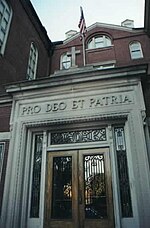Oliver, Baltimore

Oliver is a neighborhood in the Eastern district of Baltimore, Maryland. Its boundaries are the south side of North Avenue, the east side of Ensor Street, the west side of Broadway, and the north side of Biddle Street. This neighborhood, adjacent to Johns Hopkins Medical Campus and minutes from the Inner Harbor, lies east of the historic Greenmount Cemetery. The neighborhood is accessible by several bus lines, the Johns Hopkins metro station, Charm City Circulator, Pennsylvania Station (Baltimore), and freeway. In the past, Oliver has experienced economic depression, housing abandonment, and the after-effects of the Baltimore riot of 1968. In recent years, a steadily increasing number of diverse families and young professionals have returned to the Oliver community. In hand with long term homeowners, new homeowners are experiencing a transforming community. The neighborhood was a filming location for the Baltimore-based HBO drama The Wire, and was the home of the Baltimore chapter of the Black Panther Party. Neighborhood attractions include The National Great Blacks In Wax Museum.
Excerpt from the Wikipedia article Oliver, Baltimore (License: CC BY-SA 3.0, Authors, Images).Oliver, Baltimore
North Eden Street, Baltimore
Geographical coordinates (GPS) Address Nearby Places Show on map
Geographical coordinates (GPS)
| Latitude | Longitude |
|---|---|
| N 39.307777777778 ° | E -76.599333333333 ° |
Address
North Eden Street 1519
21213 Baltimore
Maryland, United States
Open on Google Maps








